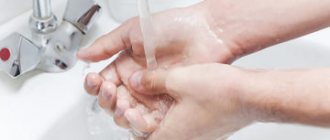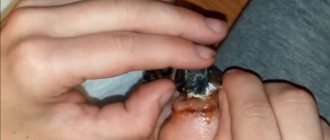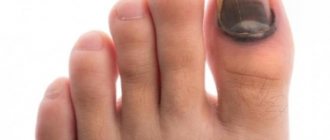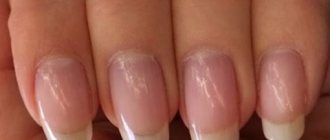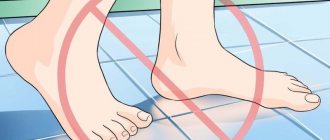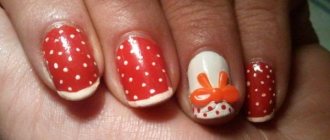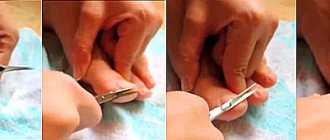Causes
In 60% of cases, onycholysis develops after a blow, from injury, or when a nail is pinched. Moreover, even a minor injury is enough that a person will not pay attention to. The second most common cause of nail onycholysis is fungal infection (onychomycosis). The disease is also caused by allergies. For example, when hands come into contact with household chemicals.
Depending on the cause, the nail may be affected only on one finger or on several fingers at the same time.
The risk group includes people who have:
- chronic skin diseases (eczema, psoriasis);
- malnutrition, deficiency of vitamins A, E, group B;
- metabolic disorders;
- predisposition to allergic reactions;
- weakened immunity, including during pregnancy and old age;
- diabetes.
The disease onycholysis often appears in workers in the chemical industry and laboratories, whose hands are constantly in contact with organic solvents and aggressive substances.
Due to the desire for beauty, women face this problem more often than men.
Onycholysis is caused by:
- nail extensions;
- improper performance of manicure or pedicure;
- injury to the cuticle area;
- the use of decorative varnishes, liquids for their removal containing harmful organic solvents;
- gel polish coating.
Almost all women like to do the procedures listed above to make their hands look attractive and well-groomed. But the first thing to remember is safety. Because many of them do not have the most favorable effect on nails. Cause allergic reactions, chemical burns, burns from an ultraviolet lamp.
Often onycholysis occurs on the hands from gel polish or shellac. Why is this happening? The reason is ignoring precautions. When drying under a UV lamp, the nail burns. Therefore, if the master says, take it out, if he bakes, you need to do it. If you tolerate the burning sensation for a couple of minutes, the consequences can be dire. You risk being left not only without a manicure, but also without nails. The burning sensation provokes a burn, a disruption of the connection between the plate and the nail bed. Therefore, you need to take your hands out from under the lamp for a few seconds until the discomfort disappears.
In addition to the above reasons, the disease is caused by long-term use of medications that increase the body's sensitivity to solar radiation. We are talking about antibiotics from the group of penicillin and tetracycline. For example, in the instructions for the drug Doxycycline, the list of adverse reactions states that it can cause photoonycholysis, a change in the color of nails.
The causes of onycholysis on the arms and legs are different. Toenails are less likely to undergo aesthetic manicure procedures, but are more often injured. Most often, detachment of the nail plate occurs on the big toe due to mechanical compression from tight closed shoes, flat feet, improper distribution of the load on the foot, disruption of its biomechanics, and long nail length.
Why does the nail come off from the nail bed on the big toe?
There are various causes of nail plate detachment on the toes.
Traumatic injury
Onychomycosis can occur due to finger injury. Mechanical, physical and chemical factors can contribute to this. The most common cause of nail peeling is a strong blow. This is a normal reaction of the body to mechanical stress. It is not always possible to preserve the nail plate in such cases, however, this pathology does not cause serious complications.
In addition to a serious bruise, detachment of the nail plate can be caused by the following traumatic factors:
- Using uncomfortable shoes. In such cases, onychomycosis develops due to constant friction;
- Frequent contact with chemical irritants (solvents, chemical reagents, washing powders and other allergens);
- Artificial nail extension.
Skin, infectious, systemic diseases
The most common cause of onychomycosis is a fungal infection of the nail. It's easy to spot. The nail plate begins to turn yellow, an unpleasant odor, itching and excessive peeling of the skin appear.
Dermatological pathologies can provoke detachment of the toenail. These include bullous dermatoses, psoriasis, atopic dermatitis, eczema, etc. Onychomycosis can also develop in chronic diseases, pathologies of the nervous, cardiovascular and digestive systems, as well as infectious and endocrine diseases.
Other causes of nail plate detachment
Sometimes the nail may fall off due to allergic reactions or taking certain medications. In such cases, except for onychomycosis itself, no pathological symptoms arise. This makes it possible to distinguish an allergic lesion of the nail plate from a fungal one.
Long-term use of antibiotics, especially fluoroquinolones and tetracyclines, also provokes the development of onychomycosis. Another reason for peeling nails is the use of low-quality cosmetics. Typically, this pathology is encountered by women and girls who use shellac or have their nails treated in beauty salons.
Kinds
Depending on the cause, there are several types of disease.
The most common onycholysis is:
- Traumatic. Nails begin to peel off after blows, wounds, burns, splinters, exposure to heat, cold, prolonged exposure to water, or wearing tight shoes. This also includes pathological changes caused by the action of acids, alkalis, solvents, and household chemicals;
- Fungal. It occurs due to the entry and reproduction of fungal infection pathogens in the subungual space. Formed as a secondary complication of onychomycosis;
- Allergic. Onycholysis develops as an allergic reaction due to taking medications with photosensitizing properties, ultraviolet irradiation (photo onycholysis), and contact of the nail plate with harmful chemicals.
Depending on the size of the affected area, onycholysis can be partial, when only a small area of the nail peels off in the form of a strip or semicircle, and complete, when it comes off entirely. Separation of the nail plate can occur from the distal (free) edge or from the lateral ridges (lateral onycholysis).
Why does my toenail come off?
There can be many reasons for a toenail peeling. But most often these are toe injuries. The plate can also come off as a result of a severe form of fungal infection. How can you become infected with a fungus? So, nail infection occurs under the following conditions:
- Pool;
- Gym;
- Bath;
- Sauna;
- Public beach;
- Kindergarten.
If one of the family members suffers from fungus on the feet and nails, it is important that he has individual soap, towel, socks, and tights. To prevent the plate from peeling off on the leg, it is important to take therapeutic measures. Also, indoor slippers should be individual. If the fungus is left untreated, not only will the nail peel off, but adjacent toenails will also begin to be affected. Some believe that nails peel off due to a lack of vitamins in the body. Of course this is not true.
The toenail does not come off immediately. At the first stage of infection of the nail plate with a fungus, some symptoms occur. This area begins to change color and an unpleasant odor occurs. Also, inflammation appears on the finger around the nail. The body's protective reaction when affected by infection is a sharp thickening and keratinization of the nail plate.
It is very easy to injure the nail, which will lead to peeling of the plate. Damage occurs when wearing tight shoes that do not fit. Girls experience a lot of stress on their toes when wearing high heels. The nail plate becomes depleted, begins to grow unevenly, and gradually begins to peel off. Also, various bruises, fractures, blows can cause the problem.
In this case, a person may complain of the following symptoms:
- Pain in the leg and finger after injury;
- Sensation of a foreign body under the nail after injury;
- The color of the nail plate becomes red, blue, black;
- When pressed, not only the nail itself hurts, but also the entire finger;
- Severe pain when walking;
- Swelling and swelling of the finger around the sore area.
How to recognize the disease?
With onycholysis, voids form under the fingernail, caused by its inability to grow to the nail bed and air entering the resulting cavity. The main symptom is a change in the color of the nail plate. It becomes cloudy, whitish-gray. In this case, the detachment border most often has uneven edges. Similar symptoms are observed on the legs.
With an infectious cause of the disease, the nail additionally changes its structure, its surface becomes rough, and the color is yellow, brown or green.
With onycholysis, the nail does not grow and becomes brittle and brittle. If an infection gets into the subungual space, a person feels discomfort, pain, and suppuration.
Psoriatic onychodystrophy
This, of course, is a medical name; psoriasis on the fingernails and toenails is popularly called this. As a rule, such a disease does not occur separately from skin psoriasis. In addition to the fact that the toenail crumbles, it is destroyed from the inside. At a certain period of time, papules may appear on the nails, which slightly resemble yellowish puddles. These papules contain pus, which is released as the nail grows. Another symptom is itching; it is impossible to immediately determine where exactly it is; it seems that it is on the fingers or under the nails. The main danger of the disease is that you can completely lose the nail plate, and before that the person will be tormented by discomfort.
And the worst thing is that psoriatic onychodystrophy is incurable; all therapy is aimed only at eliminating symptoms and discomfort. But under no circumstances should you refuse treatment; it will help reduce the risk of relapse.
Diagnostics
If you suspect detachment of the nail plate, you should visit a specialist (podiatrist, dermatologist). To confirm the diagnosis and find out the cause of onycholysis, a fungal test is performed.
Based on external signs, it can be confused with onychomycosis, psoriasis, lichen planus and other types of onychodystrophy. Therefore, differential diagnosis is needed. A fungal infection is indicated by a yellow, brown or green color of the nail, its thickening, an unpleasant odor, and itching of the skin around it.
Many who have encountered onycholysis are interested in whether it is contagious? It is not contagious in itself. But often its cause is a fungal infection, which is easily transmitted from one person to another through contact and household contact.
Treatment
Treatment of the disease is long-term, taking up to 5–6 months. Selected individually, taking into account the reason. For help, you need to contact a dermatologist, podologist, or mycologist. The larger the area peeled off, the longer the recovery will be.
Treatment for nail onycholysis includes:
- cleaning or removing the exfoliated part of the nail plate;
- fight against fungal infection, if it has been detected;
- protection of the exposed soft tissue area;
- prevention of infectious complications;
- stimulation of nail growth;
- correction of a cosmetic defect.
It is recommended to consult a doctor immediately. The use of folk remedies and methods to treat onycholysis without consultation is fraught with complications. It is very important not to let the problem take its course. The more time is lost, the less likely the nail will grow. When a cavity forms between the nail and the nail bed, the skin becomes hard over time and can no longer adhere to the nail.
The main thing that needs to be done to effectively treat nail onycholysis is to stop the influence of the traumatic factor. If the detachment occurs due to an allergy to washing powder or cleaning agent, you need to change them to others and use thick rubber gloves.
If the cause is infection, measures are necessary to destroy the pathogen. To combat the fungus, varnishes, local ointments, and creams are used. In severe cases, antifungal drugs are added orally. The course of treatment and specific medications are prescribed by the doctor. For bacterial infections, antibiotic ointments are prescribed.
If detachment of the nail plate occurs due to a nail injury, prosthetics with a special medical gel are used to correct the cosmetic defect. It differs from standard gels that are used for extensions. Made from hypoallergenic components, does not cause an allergic reaction or burn. Gel prosthetics for onycholysis helps to close soft tissues, minimize the risk of injury to the nail bed, and prevent infection. Materials for prosthetics contain antifungal and antiseptic additives. But this method can only be used in the absence of infection.
To speed up nail growth, vitamins, iron and calcium supplements are prescribed. Local remedies (oils, cuticle creams) and finger massage are also used to improve blood circulation.

